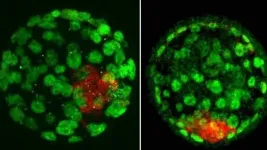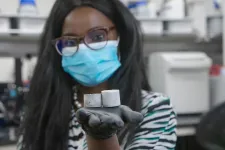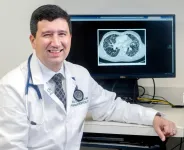New high-speed method for spectroscopic measurements
2021-06-21
(Press-News.org) Researchers at Tampere University and their collaborators have shown how spectroscopic measurements can be made much faster. By correlating polarization to the colour of a pulsed laser, the team can track changes in the spectrum of the light by simple and extremely fast polarization measurements. The method opens new possibilities to measure spectral changes on a nanosecond time scale over the entire colour spectrum of light.
In spectroscopy, often the changes of the wavelength, i.e. colour, of a probe light are measured after interaction with a sample. Studying these changes is one of the key methods to gain a deeper understanding of the properties of materials down to the atomic level. Its applications range from astronomical observations and material studies, to fundamental investigations of atoms and molecules.
The research team has demonstrated a novel spectroscopic method which has the potential to speed up measurements to read-out rates that are impossible with conventional schemes. The results have now been published in the prestigious journal Optica.
Spectroscopic measurements usually rely on separating the different colour components to different positions, where the spectrum can then be read-out by a detector array similar to a camera chip. While this approach enables a direct inspection of the spectrum, it is rather slow due to the limited speed of the large read-out array. The new method that the researchers implemented circumvents this restriction by generating a more complex state of laser light and thereby allowing a faster measurements scheme.
"Our work shows a simple way to have different polarizations for all colour components of the laser. By using this light as a probe, we can simply measure the polarization to gain information about changes in the colour spectrum," explains Doctoral Researcher Lea Kopf, lead author of the study.
The trick the researchers use is to perform a modulation in the temporal domain by coherently splitting a femto-second pulse of a laser into two parts - each having a different polarization slightly delayed in time with respect to each other.
"Such a modulation can easily be done using a birefringence crystal, where differently polarized light travels at different speeds. This leads to the spectrally-changing polarization required for our method," describes Associate Professor Robert Fickler, who leads the Experimental Quantum Optics group in which the experiment was performed.
High-speed spectroscopic measurements
The researchers have not only demonstrated how such complex states of light can be generated in the lab; they also tested their application in reconstructing spectral changes using only polarization analysis. As the latter only requires up to four simultaneous intensity measurements, a few very fast photodiodes can be used.
Using this approach, the researchers can determine the effect of narrowband modulations of the spectrum at a precision that is comparable to standard spectrometers but at high speed. "However, we couldn't push our measurement scheme to its limits in terms of possible read-out rates, as we are limited by the speed of our modulation scheme to a few million samples per second," continues Lea Kopf.
Building on these promising initial results, future tasks will include to apply the idea to more broadband light, such as super continuum light sources, and to apply the scheme in spectroscopic measurements of naturally fast varying samples to use its full potential.
"We are happy that our fundamental interest in structuring light in different ways has now found a new direction, which seems to be helpful for spectroscopy tasks which are usually not our focus. As a quantum optics group, we have already started discussing how to apply and benefit from these ideas in our quantum photonics experiments," adds Robert Fickler.
INFORMATION:
Read more on Spectral vector beams for high-speed spectroscopic measurements in Optica
Further information:
Robert Fickler
tel. +358 50?447 8492
robert.fickler@tuni.fi
[Attachments] See images for this press release:

ELSE PRESS RELEASES FROM THIS DATE:
2021-06-21
Biologists at the Universities of Bath and Vienna have discovered 71 new 'imprinted' genes in the mouse genome, a finding that takes them a step closer to unravelling some of the mysteries of epigenetics - an area of science that describes how genes are switched on (and off) in different cells, at different stages in development and adulthood.
To understand the importance of imprinted genes to inheritance, we need to step back and ask how inheritance works in general. Most of the thirty trillion cells in a person's body contain genes that come from both their mother and father, with each parent contributing one version of each gene. The unique combination of genes goes part of ...
2021-06-21
Fat biomolecules in the blood, called "serum lipids," are necessary evils. They play important roles in the lipid metabolism and are integral for the normal functioning of the body. However, they have a darker side; according to several studies, they are associated with various cancers. The medical community has fathoms to go before truly understanding the implications of different serum lipid levels in cancer.
As a major step in this direction, a group of scientists from the Key Laboratory of Carcinogenesis and Translational Research, Laboratory of Genetics, Peking University Cancer Hospital and Institute; Hua County People's Hospital; and Anyang Cancer Hospital, have successfully determined that a family history ...
2021-06-21
(BOSTON) - Research collaborators from the VA, Boston University, and the Concussion Legacy Foundation (CLF) published an inspiring new report today, "1,000 Reasons for Hope," which exclusively details the first 1,000 brain donors studied at the VA-BU-CLF Brain Bank since 2008 and how they have advanced research on concussions and CTE. The report also explains how the next 1,000 brain donors will answer critical questions that take us closer to preventing, diagnosing, and treating CTE, as well as the long-term consequences of concussion and traumatic brain injury.
"Our understanding ...
2021-06-21
Johan Gaume, an EPFL expert in avalanches and geomechanics, has turned his attention to ice. His goal is to better understand the correlation between the size of an iceberg and the amplitude of the tsunami that results from its calving. Gaume, along with a team of scientists from other research institutes, has just unveiled a new method for modeling these events. Their work appears in Communications Earth & Environment, a new journal from Nature Research.
These scientists are the first to simulate the phenomena of both glacier fracture and wave formation when the iceberg falls into the water. "Our goal was to model the explicit interaction between water and ice - but that has a substantial cost in terms of computing time. We therefore decided ...
2021-06-21
An increasing number of studies on artificial intelligence (AI) are published in the dental and oral sciences but aspects of these studies suffer from a range of limitations. Standards towards reporting, like the recently published CONSORT-AI extension, can help to improve studies in this emerging field. Watch authors Falk Schwendicke and Joachim Krois of the Charité - Universitätsmedizin Berlin, Germany, discuss the Journal of Dental Research (JDR) article "Better Reporting of Studies on Artificial Intelligence: CONSORT-AI and Beyond," moderated by JDR Editor-in-Chief Nicholas Jakubovics, Newcastle ...
2021-06-21
When the COVID-19 pandemic hit during the winter of 2020, locking down entire countries and leaving people isolated in their homes without outside contact for weeks at a time, many relationship experts wondered what that kind of stress would do to romantic couples. What they found was that when couples blamed the pandemic for their stress, they were happier in their relationships.
The findings are outlined in a paper out today in the journal Social Psychological and Personality Science.
Previous research has shown that romantic partners tend to be more critical toward each other when experiencing ...
2021-06-21
Forces of nature have been outsmarting the materials we use to build our infrastructure since we started producing them. Ice and snow turn major roads into rubble every year; foundations of houses crack and crumble, in spite of sturdy construction. In addition to the tons of waste produced by broken bits of concrete, each lane-mile of road costs the U.S. approximately $24,000 per year to keep it in good repair.
Engineers tackling this issue with smart materials typically enhance the function of materials by increasing the amount of carbon, but doing so makes materials lose some mechanical performance. By introducing nanoparticles into ordinary cement, Northwestern University ...
2021-06-21
TAMPA, Fla (June 21, 2021) -- A blood gene profile associated with a high risk of dying from a severe lung disease can also predict poor outcomes in patients with COVID-19, a multicenter retrospective study led by the University of South Florida Health (USF Health) demonstrated. The risk profile based on 50 genes could help customize how COVID-19 is treated, improve allocation of limited health care resources such as intensive care beds and ventilators, and potentially save lives.
Idiopathic pulmonary fibrosis (IPF), a disease of unknown cause, affects the lung interstitium or the space between the lung sacs and the bloodstream, leading ...
2021-06-21
UNIVERSITY PARK, Pa. -- Using solar energy to inexpensively harvest hydrogen from water could help replace carbon-based fuel sources and shrink the world's carbon footprint. However, finding materials that could boost hydrogen production so that it could compete economically with carbon-based fuels has been, as yet, an insurmountable challenge.
In a study, a Penn State-led team of researchers reports it has taken a step toward overcoming the challenge of inexpensive hydrogen production by using supercomputers to find materials that could help accelerate hydrogen separation when water is exposed to light, a process called photocatalysis.
Both electricity and solar energy can be used to separate hydrogen from water, ...
2021-06-21
Sperm size varies dramatically among different animal species. But why is sperm size so variable when they share the same job - to fertilize eggs? In a new article published in Nature Ecology and Evolution, researchers from Stockholm University show that animal sperm evolution become supercharged only when sperm swim inside females.
Sperm are the most variable cell type known, ranging in size from 0.002 millimeters in a freshwater rotifer to nearly 6 centimeters in a fruit fly. Explaining why sperm are so variable has been a major focus in evolutionary ...
LAST 30 PRESS RELEASES:
[Press-News.org] New high-speed method for spectroscopic measurements



